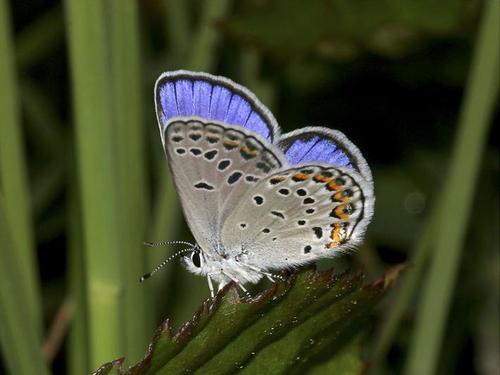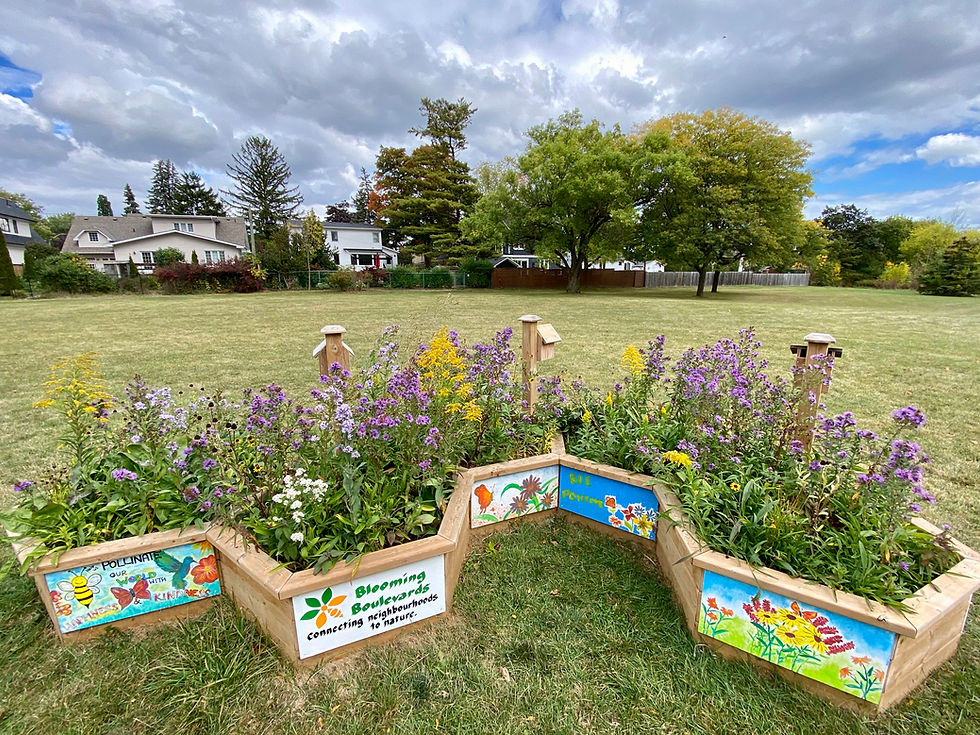Beautiful blues: an ultra-rare butterfly and its not-so-common look-alike
- Jeanne McRight

- Sep 14, 2022
- 3 min read
Updated: Sep 19, 2025
by Rob Chiasson
Touring the garden with camera in hand late afternoon August 24th, hoping to snap a couple of shots of bees or butterflies, I noticed a beautiful small blue butterfly fluttering about in the garden. It came to rest on a lanceleaf coreopsis and stood there unbothered by my camera lens which was moving progressively closer and closer. I was hoping to catch the blue upper side of the wings, not realizing at first how ornate the lower side of the wings are. I snapped several pictures and then brought the SD card inside to view on the laptop, where I got a better appreciation for the detail on the side of the wings I had taken for granted.

Wow, so exciting! The blue butterfly in Rob's garden - was it the rare/extirpated Karner blue, or the still uncommon, new-to-Ontario European common blue? Photo ©2022 Rob Chiasson.
The wings are slightly grey to opaque with several black dots outlined in white in the middle of the wings and orange to red upside down triangles at the top with black dots outlined in white above, and a white, feathery looking edge. After enjoying the beautiful detail on the wings of this little one, I searched google images for “small blue butterfly Ontario”.
The first search result I found with a similar wing was the Karner blue. I decided to post a picture to the Blooming Boulevards Garden Stewards Facebook Group with the caption Karner Blue Butterfly?, and another post to my profile page without testing my butterfly identification skills and simply saying that it looked like an artist created this butterfly. On Sunday August 28th I posted another picture, and it started a bit of a buzz. The Karner blue, declared extirpated in 2010, may have found its way back to Ontario! But alas, as experts were asked to look at the pictures, they were quickly able to identify that this was a Karner blue look alike – a European common blue.
Above: The European common blue butterfly. Bird's-foot-trefoil (Lotus corniculatus) is the main food plant. First found in 2007 near Mirabel Airport NW of Montreal, Quebec. Since then it has spread east beyond Montreal, and it was found in Eastern Ontario in the summer of 2017. It has since been found in the Toronto area. To see where this butterfly has been reported, visit: The Ontario Butterfly Atlas Online.
Once you know what butterfly to compare to, the differences between the European common blue and the Karner blue become more evident, particularly in the orange, black and white markings near the edges of the wings. The Karner blue seems to have thicker black lines above and below the orange spots, which are less triangular shaped than the European common blue. The black circles atop the orange markings of the Karner blue also appear to be filled with blue whereas the European common blue has a white circular shaped marking above the orange with an oval or round black spot in the middle. The two butterflies look very similar to the untrained eye.
Above: The tiny (2.5cm wing span) Karner blue butterfly is a specialist, relying on only wild lupines to feed its caterpillars. It has been extirpated from its range in the sandy pine barrens and oak savannahs near the shores of Lake Ontario, where fields of wild lupine once grew. Adults live roughly five days. During these few days the Karner blue must feed, mate and lay their eggs on the wild lupine leaves. Reintegration programs are being attempted, but without a consistent food supply, the success of these programs hangs in the balance.
The last recorded siting of a Karner blue occurred near St. Williams in the late 1980s. The most successful reintegration efforts are happening where there are some populations remaining in Wisconsin. Some further googling has revealed that the Karner blue is making a comeback at the Albany Pine Bush Preserve, just 500 kilometers away, so a sighting could still be possible with a day trip.
Who knows, maybe wild lupine, which is the Karner blue caterpillar’s exclusive host plant, will one day line a path for this quarter-sized butterfly back to Ontario!

Range map of the Karner blue butterfly and wild blue lupine, based on historical estimates and currently documented occurrences (based on Forest Landscape Ecology Lab, 2007) Map by A. Hess. Downloaded from https://academic.oup.com/ae/article-abstract/61/2/96/1756107
Resources
Annie Anzaroot and Monica McQuail (2021). Saving the Karner Blue Butterfly, The North American Land Trust. https://northamericanlandtrust.org/saving-the-karner-blue-butterfly/
Species Status Assessment: Karner Blue (2014), The State of New York. https://www.dec.ny.gov/docs/wildlife_pdf/sgcnkarnerblue.pdf
The Butterflies of Ontario, 2022 Rick Casavin. https://www.ontariobutterflies.ca



















Comments